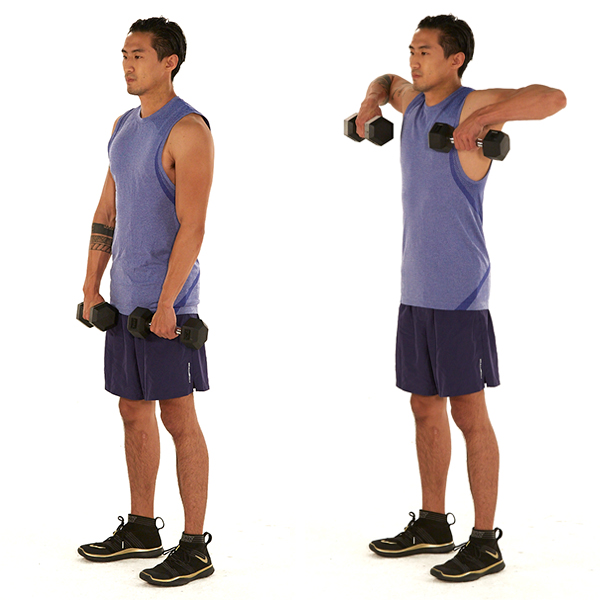Looking for a better, more systematic approach to strength training? Consider the pull day workout and its counterpart, the push day workout. Dividing your workouts between push and pull days is one of the most straightforward ways to create a fitness plan that will allow you to vary your movements, optimize your training time, and avoid injury.
What Is a Pull Day?
The typical pull day workout consists of upper-body exercises that utilize a pulling motion. They primarily engage the biceps, forearms, and back muscles.
“Because a majority of the ‘pull’ muscle groups make up the back of the body (or posterior chain), these are extremely important for posture and mobility,” says BODi Fitness Programming Manager Amanda Herrera. Plus, pulling is key to everyday functional movement, whether you’re paddling a kayak or lifting grocery bags.
How Is It Different From Push Day?
A push day workout focuses on pushing exercises that target the opposing muscles, including the chest, shoulders, and triceps. Alternating between pushing and pulling exercises allows you to work one group of muscles while the other group recovers.
This is why it’s possible to do a push day workout after a pull day workout without taking a rest day. Ultimately, this training method allows you to accomplish more strength training in a shorter period.
Weightlifting programs on BODi — such as LIIFT4 and Body Beast — follow this principle by targeting different muscle groups on different days to make sure you hit every workout hard and maximize muscle building.
What Are the Best Pull Exercises?
Try incorporating these exercises into your training plan to get the most out of your pull day workout.
1. Dumbbell bent-over row
- Stand with your feet hip- to shoulder-width apart, holding a dumbbell in each hand. Brace your core, hinge at your waist to push your hips back, bend your knees slightly, and lower your torso until it’s nearly parallel to the floor. Keep your glutes engaged to protect your lower back.
- Let the dumbbells hang at arm’s length with your palms facing each other. Engage your shoulder blades to keep your shoulders pulled back. This is the starting position.
- Without moving your torso, and while keeping your elbows tucked and back flat, row the weights to your sides as you squeeze your shoulder blades together. Make sure there’s a 90-degree bend in the elbow, so you’re rowing to your ribs and not armpits.
- Pause, and then lower the weights back to the starting position.
2. Pull-up
- Grab a pull-up bar with an overhand grip that’s slightly wider than shoulder-width. Hang at arm’s length with your arms straight (a position known as a dead hang) and your ankles crossed behind you.
- Without swinging or kipping (using momentum to propel you upward), engage your lats and squeeze your shoulder blades together as you pull your chin to the bar.
- Pause, and then lower yourself back to a dead hang.
3. Renegade row
- Assume a push-up position with your hands gripping two hex dumbbells. Your hands should be in line with and slightly wider than your shoulders. This is the starting position.
- Keeping your core engaged, elbows tucked, and body straight from head to heels, lift the dumbbell in your right hand to the side of your torso. Make sure there’s a 90-degree bend in the elbow, so you’re rowing to your ribs and not armpits.
- Pause, and then return to the starting position. Repeat, this time rowing the dumbbell in your left hand. Continue alternating sides.
4. Dumbbell biceps curl
- Stand with your feet hip-width apart, holding a pair of dumbbells at arm’s length by your sides, palms facing forward.
- Keeping your core engaged and elbows at your sides, curl the weights toward your shoulders. Avoid swaying your body.
- Pause, and then slowly lower the weights to return to the starting position.
5. Upright dumbbell row

- Stand tall, holding a pair of dumbbells at arm’s length in front of your thighs, palms facing towards you.
- Keeping your core engaged, back straight, and weights close to your body, lift the dumbbells until your elbows reach shoulder height.
- Pause, and then reverse the movement to return to the starting position.
6. Zottman curl
- Stand tall, holding a dumbbell in each hand at arm’s length by your sides, palms facing forward (underhand grip).
- Keeping your elbows tucked and locked by your sides, curl the weights toward your shoulders.
- Rotate the dumbbells 180-degrees, so your palms are now facing down. Lower the weights back down to your sides and then flip your grip again (to underhand) to return to the starting position.
What’s a Good Push/Pull Day Schedule?
One way to structure a push/pull training plan that targets the whole body is to combine leg and core exercises and alternate between the three types of workouts. So, for example, your weekly training schedule may look like this:
- Monday: Push day workout
- Tuesday: Pull day workout
- Wednesday: Legs and core workout
- Thursday: Push day workout
- Friday: Pull day workout
- Saturday: Legs and core workout
- Sunday: Rest
However, If you’d prefer to have a mid-week rest day or combine core or leg work with your push and pull days, that’s fine too. Just be sure to keep your push and pull workouts on separate days.
If you want to leave the workout programming to the experts, all the weightlifting programs on BODi utilize some sort of split training for better efficiency, optimized rest, and faster growth.
The post Build Your Upper Body More Efficiently With a Pull Day Workout appeared first on BODi.

0 Comments